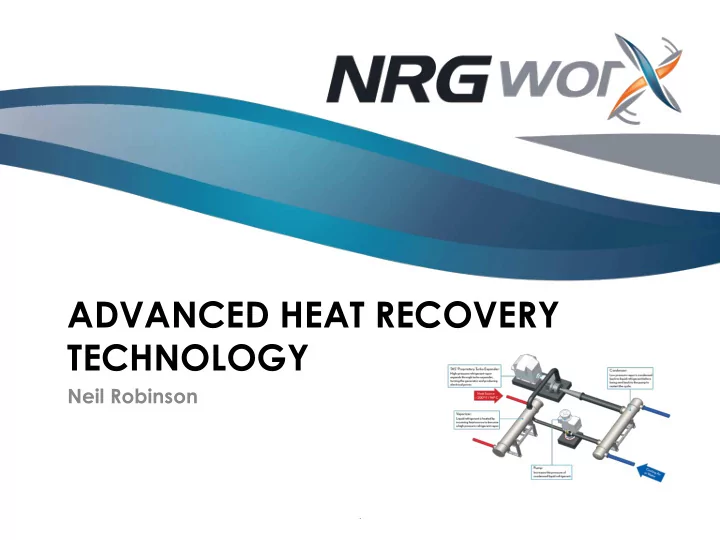

ADVANCED HEAT RECOVERY TECHNOLOGY Neil Robinson . ¡
Introduction • NRG WORX, A newly formed group of industry specialists which brings together over 40 – years of power plant development experience and capability Our niche market is the provision of specialized technology to the power – generation industry that will Reduce Fossil Fuel Consumption • Reduce Emissions • Reduce Noise • Reduce Capital Expenditure • Reduce Operation and Maintenance Burdens • Improve Power Plant Efficiency • Solutions include – Project Development • IPP • BOOT • BOO • EPC • Technology Provision • 20/11/13 2
Technology Brief The technology we are currently offering for your application has been • available for several decades albeit, in a much smaller scale, The old technology primarily focused on low quality heat sources, such as • cooling water circuits in diesel and gas engines, circa 3 to 500KW units, However In recent times the traditional Organic Rankine Cycle (ORC) • technology has undergone a significant step change , and can now compete head to head with traditional Gas Turbine Combined Cycle Technology, This step change has delivered • • Utility Size Solution modules up to 15MW • Improved Process Performance, (circa 51%) • Reduced Capital Costs, • Full Modularisation • Rapid Site Installation 20/11/13 3
ORC Process Overview • – The technology uses an organic fluid, in this case Oil to absorb the waste heat exiting the Exhaust Stack of a Gas Turbine via a heat exchanger – The Oil is circulated from the exhaust heat exchanger to the skid mounted ORC unit, which via a second heat exchanger allows the heat to be transferred from the oil to a closed loop gas circuit, in this case a refrigerant which expands when heated. – The energy in the expanded gas is utilized via an expander to drive the generator, and produces electrical energy at 11KV – The energy depleted expanded gas is then circulated through a cooling loop, (air cooled condenser) and is delivered back to the skid mounted heat exchanger to begin the cycle again 20/11/13 4
ORC Module 20/11/13 5
CCGT v ORC Comparison • Conventional CCGT v Heat To Energy Technology (ORC) (Based on a 120MW CCGT 2-2-1 configuration) CCGT ORC Capex 100% 90% Installation Time 26 Months 16 Months Consumes Water Yes No Efficiency (LM6000PD) 51% 51% Operations Resources 18 ( 3 shift systems, 6 men per shift ) 0(Unmanned) Maintenance Cycles 8760 hrs 50 to 70,000 hrs NOTE COMPLETELY UNMANNED COMBINED CYCLE POWER PLANT, OPERATED AND DESPATCHED REMOTELY 20/11/13 6
Performance Review ORC 20/11/13 7
ORC Recovery Model 20/11/13 8
Typical Performance 20/11/13 9
Operational Features – UNMANNED OPERATION • Simple start stop procedures • Automatic and continuous operation • Partial load operation down to 10% of nominal power • Partial load conditions are obtained by modulating a 3 way valve to enable the ORC to automatically respond to external load variations • High efficiency even at 50% of nominal load , (electrical efficiency is circa 90% of nominal electrical efficiency) • No operator Attendance needed, due to the absence of a high pressure vapor generator (HRSG) • Quiet operation • High Availability circa 98% • Low Maintenance requirements, circa 3 – 5 hrs per week • Long Life, more than 20 years 20/11/13 10
Technical Features – Low Complexity • Low RPM, i.e. no reduction gears needed for the generator • No raw water treatment plant needed • No demineralized water treatment plant needed • No Chemical dosing plant • No working fluid superheating • No high pressure steam generator • No corrosion issues • Added thermal Stability • Simpler control system architecture • Three simple blocks construction – Heat Exchanger – ORC unit – Air cooled condenser 20/11/13 11
Commercial Overview Levelised Cost of Energy (LCOE) = $150/MWhr (Gas $10/GJ) LCOE =(b*c) / (P*H) + f/h + OM/H + m *OM (n,b) – Where – b = Levelised carrying charge factor of cost of money » c= Total plant cost » H = Annual operating hours » P = Net rated output (kw) » F = Levelised cost of fuel ($/kwh) » H = Net Rated efficiency of the plant (LHV) » OM = Fixed O&M costs for base load operation ($/kwhr) » (n,b) = Variable O&M costs for base load operation, ($/kwhr) » M = Maintenance cost escalation factor » Annual Fuel saving circa $7.25M Basis of Comparison • 2 LM6000PD – Gas Fuel @ $10/GJ – Location North West of WA – Base Load Operation – 20/11/13 12
Typical Site Layout Overall Space Required, Circa 100M x 40M 79,000 mm 20,000 mm 24,000 mm 20/11/13 13
Modular Design • Designed for easy transport • Simple install and assembly • Phased Capital Spending Matched to Resource Availability 20/11/13 14
Typical Heat Exchanger 20/11/13 15
Recommend
More recommend